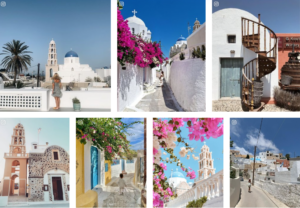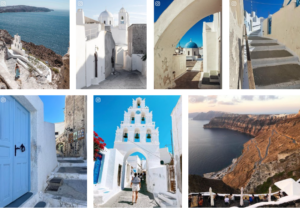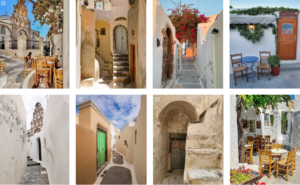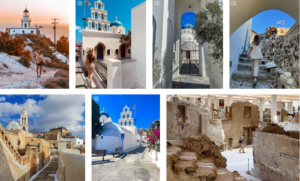The famous caldera and outrageously scenic views over the Aegean are an unforgettable sight on any holiday in Santorini, especially from show-stopping villages like Oia, Fira and Imerovigli. But wait a minute! This is where you find out that there are other villages in Santorini that can’t wait to be discovered. Messaria, Pyrgos, Exo & Mesa Gonia, Emporio and Akrotiri (beyond the famous archaeological site with the same name) hide Venetian castles, family-run tavernas and local crafts. They all preserve Cycladic and Medieval influences and are some of the best places to discover the roots of Santorini’s culinary riches.
You’ll find them inland, away from the caldera, often surrounded by vineyards and showcasing Santorini’s traditional subterranean architecture or 19th-century captain’s houses. So prepare your camera feed for hidden gems that will get you closer to the authentic soul of Santorini and make you look at Greece’s stellar island in a whole new light.

Right in the centre of Santorini, Messaria is surrounded by vineyards that are responsible for large quantities of local wine and, despite having plenty of facilities for visitors, has held on to its unique Cycladic character. You can discover it all just by wandering down its narrow alleyways and past picturesque churches like Agios Dimitrios, Agia Varvara and Agia Irini. Keep an eye out for the Argyros Mansion, built in 1888 by businessman Giorgos Argyros and renovated to welcome visitors, as well as a knitting factory. Both are testament to Messaria’s 19th-century status as Santorini’s industrial hub.
There are a few traditional tavernas in Messaria (good for seafood meze) as well as old-time cafes and delis. And just outside the village, you’ll find Canava Santorini, the island’s only ouzo and tsipouro distillery, operating since 1974. It offers guided tours and tastings that will teach you everything you need to know about ouzo and tsipouro and local grape varieties.
Meanwhile, neighbouring Vothonas (so close that it has practically merged with Messaria) is distinctive for most of its houses being built below ground. The architecture is similar to that of Messaria, with scenic cobblestone alleyways and churches. But the real draw here is the Santorini Wine Museum (within the Koutsogianopoulos Winery). The entire museum is built in a cave 8m below ground, telling the history of Santorini’s wine culture from 1660.

The medieval village of Pyrgos Kallistis (or just Pyrgos) may just be the most popular of Santorini’s lesser-known authentic settlements. Located at the island’s highest point, it once served as a fortified lookout due its panoramic views over the entire island, all the way to Oia. It was also once the capital of Santorini (when the castle at Skaros was abandoned in the 1880s, just before the administrative hub was moved to Fira) and is now protected as a listed settlement.
Your time walking along the alleyways of Pyrgos will be spent admiring elegant neoclassical mansions and cute whitewashed houses, as well as archways and churches. Paths lead to the highest point of the hill, from where you can enjoy spectacular views. The highlight at the top is the castle known as Kasteli (as all of Santorini’s Venetian castles are known), surrounded by houses that create a natural fortress. Within the castle are the churches of Eisodion of Theotokou and Theotokaki (one of the oldest churches on Santorini, dating from the 10th century), along with the Church of the Holy Trinity, housing a collection of icons and other rare ecclesiastical items. When hunger calls, there is a multitude of cafes and restaurants around the back of the castle, or you could choose the ones closest to the castle, which offer excellent sunset vistas.

Pyrgos is also known for its Cultural Village, a multi-purpose exhibition area that houses exhibits and items from Santorini’s culinary and winemaking past (heads up to the tomato and fava puree) as well as other cultural traditions. A restaurant has recently been added, so pack your appetite. And you can follow that with wine tasting at Santo Wines, one of Santorini’s premier winemakers, at an estate overlooking the caldera. Note that over Easter (on Good Friday in particular), Pyrgos plays host to Santorini’s most extravagant fireworks display, where locals light up lamps and tin cans across the village.

The beauty of Pyrgos is that there are another couple of settlements right next door, separated by just metres of land. Exo Gonia and Mesa Gonia (Episkopi Gonia) offer traditional architecture in a colour palette of white or ochre, with quaint cobblestone streets and archways.
Exo Gonia is the larger of the two but it is still a sleepy village, built on a hill and with churches popping up here and there, of which Agios Charalambos is one of the three biggest on Santorini and one of only two with a tiled roof. Meanwhile, in Mesa Gonia you can visit the Church of Panagia Episkopi, built between 1081 and 1118 and one of the most significant Venetian monuments on the island.
However, the churches aren’t the main reason for visiting these villages. They happen to be surrounded by five of the best wineries in Santorini. Most feature traditional subterranean cellars (known as kanaves) and vertical koulouria (the curled, pruning system of vines that helps preserve water and offers protection from the wind). Both are trademarks of Santorini vineyards. And Mesa Gonia boasts a microbrewery called The Donkey Experience, specializing in unfiltered, unpasteurized and preservative-free lagered ales and welcoming you to tour the facilities to learn about the brewing process, try the beers and visit the shop.
A labyrinth of narrow cobblestone streets and alleyways leads away from the square, taking you past small houses and grand mansions, as well as the customary hidden churches (look out for the churches of Zoodochos Pigi and Agion Anargyron). And as you might now have come to expect, the village is also surrounded by vineyards. Indeed, it’s another area with a robust winemaking tradition, with four wineries operating here – Gavalas, Boutari, Hatzidakis and Venetsanos – all of which provide wine tastings.
Back within the village, the Symposium Cultural Centre is a sleekly-built venue that is part artisan workshop and part exhibition space, with a cafe and a full program of events and seminars (including ones where you’ll learn how to make a traditional tsabouna musical instrument). Meanwhile, at the entrance to the village, there are art galleries and pottery workshops. And for something a little different, there’s the choice of horseback riding around the village and along the caldera and cookery classes at Anydro Farm using some of Santorini’s finest produce, including its famous cherry tomatoes.

The biggest of Santorini’s inland villages, Emporio (also known as Nimporio) is located near cosmopolitan Perissa and (like Pyrgos) features a Venetian castle (Kasteli) at the top of the hill, right in the middle of the village. Indeed, similarities with Pyrgos don’t end there, as Emporio’s houses are packed next to each other to create a continuation of the fortified walls of the castle, whose domed hallway entrance (known to locals as Porta) is still standing. Emporio is one of Santorini’s best examples of Venetian city planning, with scenic little alleyways and even narrower passes hiding archways, tunnels and courtyards and houses with colourful doors which face towards the inside of the castle. Meanwhile, the 15th-century Goulas Tower has mysterious origins, involving several monks from the fabled Monastery of Saint John the Baptist of Patmos sequestering several artefacts for safe keeping in the castle.
As in villages on so many Greek islands, you won’t be able to walk three steps without finding a church. Notable standouts include Panagia of Agios Georgios, the Church of the Metamorphosis of our Saviour and the Holy Church of Agias Theodosias. There’s a traditional little cafe within the castle settlement, but the choice of tavernas and restaurants is limited. You’ll find a greater choice around the castle.

Last on our tour of inland villages in Santorini is Akrotiri. Most people know of Akrotiri from the world-famous archaeological site in the southwest of the island, referred to as the Greek Pompeii because it has been preserved by volcanic ash from the eruption in 1600 BC. The settlement, which was once home to some 30,000 people, was rediscovered and excavated in 1967 and walking around its remarkably preserved streets and two-storey houses is a must on your holidays in Santorini.
However, also worth seeking out is the small and quiet village of Akrotiri, around 2.2km to the north and also famous for its Venetian castle (Kasteli), which is similar to those in Pyrgos and Emporio. There are two churches in the castle (the churches of the Holy Trinity and of Panagia Flevariotissa) and numerous eating options and a cocktail bar in the village. Just outside the village is a horseback riding school, offering tours of the area. And if you’re in the mood for seafood, it’s worth heading to the coast just beyond the Akrotiri archaeological site, where you can combine your visit with a dip at Santorini’s famous Red beach.
So which of Santorini’s inland villages are you putting on your holiday bucket list? Whichever you choose, they are among Santorini’s less touristy and authentic spots and visiting gives you a feeling of what it means to live like a local.